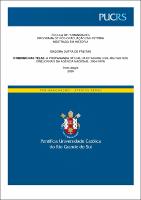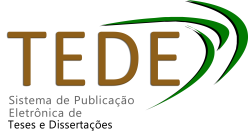| Share record |


|
Please use this identifier to cite or link to this item:
https://tede2.pucrs.br/tede2/handle/tede/9150| Document type: | Dissertação |
| Title: | Otimismo nas telas : a propaganda oficial da ditadura civil-militar nos cinejornais da agência nacional (1964-1979) |
| Author: | Freitas, Isadora Dutra de  |
| Advisor: | Maia, Tatyana de Amaral |
| Abstract (native): | A ditadura civil-militar (1964-1985) manteve ativo um extenso aparato responsável pela produção de sua imagem pública. Através de instituições oficiais, produziu e distribuiu conteúdos informativos a respeito da rotina presidencial, controlando as formas de representação do regime. Assim, objetivo central desta dissertação é analisar como o Estado manteve ativo este aparato propagandístico responsável por elaborar sua autoimagem, dispondo de narrativas positivas e silenciando aspectos sensíveis. Para tanto, utilizamos como arcabouço documental os cinejornais produzidos pela Agência Nacional, principal órgão de informação do governo entre os anos de 1964-1979. Através da análise de conteúdo, realizamos o processo de estudo das fontes em duas etapas, estabelecendo o recorte temático através do levantamento quantitativo e, posteriormente, uma análise qualitativa do discurso em consonância com as imagens. Estes pequenos noticiários, exibidos nas salas de cinema, tinham a função de informar a população acerca dos principais assuntos daquela semana, enfatizando a agenda presidencial, tornando-se uma importante ferramenta de propaganda. Porém, esta estratégia não foi uma inovação da ditadura civil-militar. O cinejornalismo foi utilizado largamente como uma expressão do discurso oficial, principalmente nos regimes totalitários da Europa. No Brasil, ganhou notoriedade durante o Estado Novo (1937-1945), período no qual se iniciou um processo de sistematização da propaganda oficial. Durante a ditadura, estas produções foram novamente incorporadas como forma de legitimação do governo. Entretanto, considerando o contexto marcado pela censura e práticas de terrorismo de Estado, cortejamos nossa fonte primária com a opinião de críticos e especialistas em cinema publicadas na imprensa. Assim, foi possível contemplar com maior profundidade dados que eram omitidos pela Agência Nacional. Desta forma, através da análise dos símbolos e temáticas mais recorrentes, pudemos afirmar que estas representações se basearam no binômio Segurança e Desenvolvimento. |
| Abstract (english): | The civil-military dictatorship maintained an extensive apparatus responsible for the production of its public image. Through official institutions, it produced and distributed informational content about the presidential routine, controlling the forms of representation of the regime. Thus, the main objective of this dissertation is to analyze how the State kept active this propaganda apparatus responsible for elaborating its self-image, having positive narratives and silencing sensitive aspects. To this end, we used as a documentary framework the newsreels produced by the National Agency, the main government information agency between the years 1964 and 1979. Through content analysis, we carried out the process of studying the sources in two stages, establishing the thematic focus through the quantitative survey and, subsequently, a qualitative analysis of the discourse in line with the images. These small newscasts, shown in movie theaters, had the function of informing the population about the main subjects of that week, emphasizing the presidential agenda, becoming an important propaganda tool. However, this strategy was not an innovation of the civil-military dictatorship. Newsreel was widely used as an expression of official discourse, mainly in the totalitarian regimes of Europe. In Brazil, it gained popularity during the "Estado Novo", a period in which a process of systematizing official propaganda began. During the dictatorship, these productions were again incorporated as a way of legitimizing the government. However, considering the context marked by censorship and practices of State terrorism, we courted our primary source with the opinion of critics and cinema experts published in the press. Therefore, it was possible to contemplate in greater depth the data that was omitted by the National Agency. Thus, through the analysis of the most recurring symbols and themes, we were able to affirm that these representations were based on the binomial Security and Development. |
| Keywords: | Ditadura civil-militar Agência nacional Cinejornais Propaganda política Otimismo Civil-military dictatorship National agency Newsreels Political propaganda Optimism |
| CNPQ Knowledge Areas: | CIENCIAS HUMANAS::HISTORIA |
| Language: | por |
| Country: | Brasil |
| Publisher: | Pontifícia Universidade Católica do Rio Grande do Sul |
| Institution Acronym: | PUCRS |
| Department: | Escola de Humanidades |
| Program: | Programa de Pós-Graduação em História |
| Access type: | Acesso Aberto |
| Fulltext access restriction: | Trabalho não apresenta restrição para publicação |
| URI: | http://tede2.pucrs.br/tede2/handle/tede/9150 |
| Issue Date: | 20-Mar-2020 |
| Appears in Collections: | Programa de Pós-Graduação em História |
Files in This Item:
| File | Description | Size | Format | |
|---|---|---|---|---|
| DISSERTAÇÃO VERSÃO FINAL - Isadora Freitas (003).pdf | ISADORA_DUTRA_DE_FREITAS _DIS | 2.91 MB | Adobe PDF |  Download/Open Preview |
Items in DSpace are protected by copyright, with all rights reserved, unless otherwise indicated.




